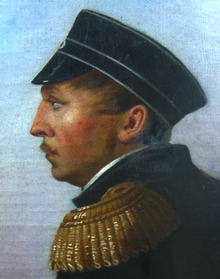- Pavel Nakhimov
-
Pavel Stepanovich Nakhimov (Russian: Павел Степанович Нахимов; July 5 [O.S. June 23] 1802 – July 12 [O.S. June 30] 1855 was one of the most famous admirals in Russian naval history, best remembered as the commander of naval and land forces during the Siege of Sevastopol during the Crimean War.
Biography
Born in the Gorodok village of Vyazma district of Smolensk region. Nakhimov entered the Naval Academy for the Nobility (Morskoy Dvoryanskiy Korpus) in Saint Petersburg in 1815. He made his first sea voyage in 1817, aboard the frigate Feniks ("Phoenix"), to the shores of Sweden and Denmark. Soon afterwards he was promoted to the rank of non-commissioned officer. In February 1818 he passed examinations to become a midshipman and was immediately assigned to the second Fleet Crew (Flotskiy Ekipazh) of the Russian Imperial Navy's Baltic Fleet.
At the beginning of his naval career, Nakhimov's experience was limited to the voyages in the Baltic Sea and a more extensive trip from the White Sea port of Arkhangelsk to Kronstadt naval base near St. Petersburg. His lucky break came in March 1822, when he was assigned to the frigate Kreiser ("Cruiser"); the vessel took part in a round-the-globe expedition commanded by well-known Russian explorer Mikhail Petrovich Lazarev, who had already undertaken several such voyages.
During the three-year voyage, Nakhimov was promoted to the rank of lieutenant. On conclusion of this adventure, he received his first award, the Order of Saint Vladimir IV degree.He returned to his native Smolensk and was assigned to the 74-gun warship Azov, which made its maiden voyage from Arkhangelsk to Kronstadt in autumn of 1826.
In the summer of 1827, Azov sailed to the Mediterranean as flagship of the Russian squadron under command of Rear-Admiral Lodewijk van Heiden for a joint expedition with the French and British navies against the Ottomans. Just before departure, Azov was visited by Tsar Nicholas I, who ordered that in the case of hostilities, to deal with the enemy "as the Russians do."
Azov, under then-Captain First Rank M.P. Lazarev, most distinguished itself in the 1827 battle of Navarino, at which the allied British-French-Russian fleet totally destroyed the Ottoman fleet. For his outstanding gunnery performance during the battle, Nakhimov was promoted to the captaincy of a trophy ship and was decorated by the allied governments.
 Bust of admiral Pavel Nakhimov at the Russian Black Sea Fleet Museum in Sevastopol
Bust of admiral Pavel Nakhimov at the Russian Black Sea Fleet Museum in Sevastopol
During the Crimean war Nakhimov distinguished himself by annihilating the Ottoman fleet at Sinope in 1853. His finest hour came during the siege of Sevastopol, where he and Admiral V. A. Kornilov organized from scratch the land defense of the city and its port, the home base of the Russian Black Sea Fleet. As the commander of the port and the military governor of the city, Nakhimov became in fact the head of the Sevastopol naval and land defense forces. On July 10 [O.S. June 28] 1855, while inspecting the forward-defense positions on Malakhov kurgan he was fatally wounded by a sniper and died two days later.
Nakhimov was buried inside St Vladimir's Cathedral in Sevastopol along with Mikhail Lazarev, V.A. Kornilov and Vladimir Istomin. There is a monument erected in his memory. The Imperial government presented other posthumous honors as well--naming the Naval college in Saint Petersburg after him, and establishing the Order of Nakhimov (with two degrees) and the Nakhimov Medal for Navy personnel. The Order of Nakhimov was preserved as one of the highest military decorations in Soviet Union and, upon its dissolution, in Russia.
In Soviet Union, Nakhimov Naval Schools were introduced for teenagers, named after the admiral.
Ships named after the Admiral
- Admiral Nakhimov a Russian armoured cruiser (sank 1905).
- Original name of Chervona Ukraina a Svetlana class light cruiser (sank 1941).
- Admiral Nakhimov a Sverdlov class cruiser (scrapped 1961).
- Admiral Nakhimov a Soviet passenger liner (sank 1986).
- Admiral Nakhimov a Kresta II class cruiser (scrapped 1991).
- Admiral Nakhimov (formerly Kalinin) a Kirov class battlecruiser (active).
Honours and awards
- This article incorporates information from the equivalent article on the Russian Wikipedia.
- Order of St. Vladimir, 4th class (1825; the voyage on the frigate Cruiser)
- Order of Saint George, 4th class (1827; for service in the Battle of Navarino
- Order of St. Anna, 2nd class (1830)
- Order of St. Anna, 2nd class with the Imperial Crown (1837; for diligent and zealous excellent service)
- Order of St. Vladimir, 3rd class (1842; for diligent and zealous excellent service)
- Mark of distinction for service bezporochnoy XXV years. (1846)
- Order of St. Stanislaus, 1st class (1847)
- Order of St. Anna, 1st class (1849)
- Order of St. Anna, 1st class with the Imperial Crown (1851)
- Order of St. Vladimir, 2nd class (1853; For the successful transfer of 13th Division)
- Order of Saint George, 2nd class (1853; For the victory at Sinope)
- Order of the White Eagle (Russia), (1855; For actions in the defence of Sevastopol)
- Order of the Bath (United Kingdom)
- Order of the Redeemer (Greece)
Categories:- 1802 births
- 1855 deaths
- Imperial Russian Navy admirals
- Russian military personnel of the Crimean War
- Russian military personnel killed in the Crimean War
- Russian military personnel killed in action
- Recipients of the Order of the White Eagle (Russian)
- Recipients of the Order of Saint George II Class
- Recipients of the Order of Saint George IV Class
- Recipients of the Order of Saint Stanislaus, 1st class
- Recipients of the Order of St. Anna, 1st Class
- Recipients of the Order of St. Vladimir, 2nd class
- Recipients of the Order of the White Eagle (Russia)
- Order of the Bath
- Recipients of the Order of the Redeemer
Wikimedia Foundation. 2010.

